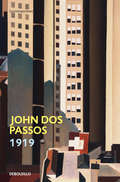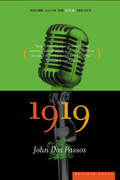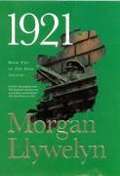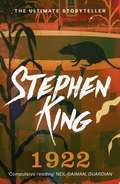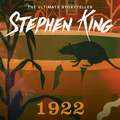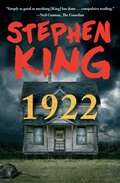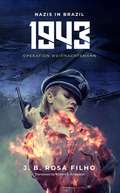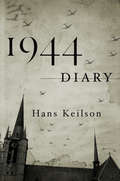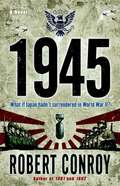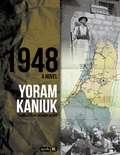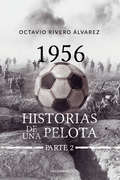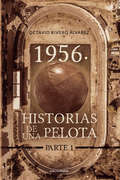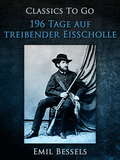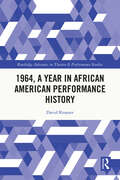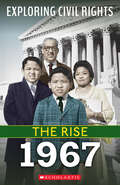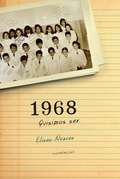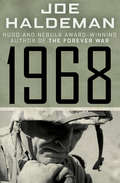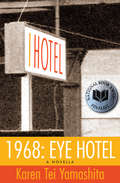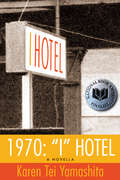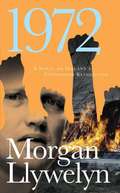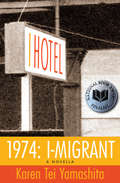- Table View
- List View
1919: The U. S. A. Trilogy (Trilogía USA #Volumen 2)
by John Dos PassosSegunda entrega de la Trilogía USA: un retrato incomparable de América desde el nacimiento del siglo hasta la Depresión de 1929. El estallido de la Primera Guerra Mundial y la participación de Estados Unidos cobran protagonismo en esta novela -segunda parte de la Trilogía USA- que conserva parte de los personajes que pululaban por Paralelo 42, el mismo vigor narrativo y la voz histórica de Woodrow Wilson, Theodore Roosevelt o el Soldado Desconocido para contarnos cómo la avaricia de la sociedad estadounidense de los felices años 20 no se detiene ante nada. Reseña:«Considero a John Dos Passos el más grande escritor de nuestro tiempo.»Jean-Paul Sartre
1919: Volume Two of the U.S.A. Trilogy (U.S.A. Trilogy #2)
by John Dos PassosWith 1919, the second volume of his U.S.A. trilogy, John Dos Passos continues his "vigorous and sweeping panorama of twentieth-century America" (Forum), lauded on publication of the first volume not only for its scope, but also for its groundbreaking style. Again, employing a host of experimental devices that would inspire a whole new generation of writers to follow, Dos Passos captures the many textures, flavors, and background noises of modern life with a cinematic touch and unparalleled nerve.1919 opens to find America and the world at war, and Dos Passos's characters, many of whom we met in the first volume, are thrown into the snarl. We follow the daughter of a Chicago minister, a wide-eyed Texas girl, a young poet, a radical Jew, and we glimpse Woodrow Wilson, Theodore Roosevelt, and the Unknown Soldier. 1919 provides an incomparable portrait of America from the turn of the century to the Depression of 1929.
1921 The Great Novel of the Irish Civil War
by Morgan LlywelynNovel about the beginning of Irish independence from England, and the subsequent civil war, seen through the eyes of a fictional journalist. Some violence.
1922
by Stephen KingThe chilling novella featured in Stephen King's bestselling collection Full Dark, No Stars, 1922 - about a man who succumbs to the violence within - is now available as a stand-alone publication.I believe there is a man inside every man, a strangerSo writes Wilfred James in his confession. It's 1922. Wilfred owns eighty acres of farmland in Nebraska that have been in the family for generations. His wife, Arlette, owns an adjoining one hundred acres.But if Arlette carries out her threat to sell her land to a pig butcher, Wilfred will be forced to sell too. Worse, he'll have to move to the city. But he has a daring plan. It may work if he can persuade his son. A powerful tale of betrayal, murder, madness and rats, 1922 is a breathtaking exploration into the dark side of human nature from the great American storyteller Stephen King. It was adapted into a film from Netflix.
1922
by Stephen KingThe chilling novella featured in Stephen King's bestselling collection Full Dark, No Stars, 1922 - about a man who succumbs to the violence within - is now available as a stand-alone publication.I believe there is a man inside every man, a strangerSo writes Wilfred James in his confession. It's 1922. Wilfred owns eighty acres of farmland in Nebraska that have been in the family for generations. His wife, Arlette, owns an adjoining one hundred acres.But if Arlette carries out her threat to sell her land to a pig butcher, Wilfred will be forced to sell too. Worse, he'll have to move to the city. But he has a daring plan. It may work if he can persuade his son. A powerful tale of betrayal, murder, madness and rats, 1922 is a breathtaking exploration into the dark side of human nature from the great American storyteller Stephen King. It was adapted into a film from Netflix.(P) 2010 Simon & Schuster, Inc.
1922
by Stephen KingThe chilling novella featured in Stephen King&’s New York Times bestselling collection Full Dark, No Stars, 1922 is about a man who succumbs to the violence within—setting in motion a grisly train of murder and madness.Wilfred James owns eighty acres of farmland in Nebraska that have been in his family for generations. His wife, Arlette, owns an adjoining one hundred acres. She wants to sell her land but if she does, Wilfred will be forced to sell as well. James will do anything to hold onto his farm, and he'll get his son to go along. Betrayal, murder, madness, rats, 1922 is a breathtaking exploration into the dark side of human nature from the great American storyteller Stephen King.
1942: A Novel
by Robert ConroyDecember 7 is "the date which will live in infamy." But now Japan is hatching another, far greater plan to bring America to its knees. . . . The Japanese surprise attack on Pearl Harbor was a resounding success-except for one detail: a second bombing mission, to destroy crucial oil storage facilities, was aborted that day. Now, in this gripping and stunning work of alternate history, Robert Conroy reimagines December 7, 1941, to include the attack the Japanese didn't launch, and what follows is a thrilling tale of war, resistance, sacrifice, and courage. For when Admiral Isoroku Yamamoto sees how badly the United States has been ravaged in a two-pronged strike, he devises another, more daring proposal: an all-out invasion of Hawaii to put a stranglehold on the American Pacific Fleet. Yamamoto's strategy works brilliantly-at first. But a handful of American soldiers and a determined civilian resistance fight back in the face of cruelty unknown in Western warfare. Stateside, a counterassault is planned-and the pioneering MIT-trained aviator Colonel Jimmy Doolittle is given a near-impossible mission with a fleet of seaplanes jury-rigged into bombers. From spies to ordinary heroes and those caught between two cultures at war, this is the epic saga of the Battle of Hawaii-the way it very nearly was. . . .
1943 -- Operation Weihnachtsmann: Nazis in Brazil
by Jb Rosa FilhoSuspenseful novel about attempts of Nazi Abwehr agent to subvert Brazil's valiant efforts in support of the Allied war effort during World War Two -- a little known and much neglected theater of that critically important event.
1944 Diary
by Damion Searls Hans Keilson[1944 Diary] is a deeply personal account, made even more remarkable that it was written during World War II and the horrors of the Holocaust . . . A moving and fascinating read." —Library JournalIn 2010, FSG published two novels by the German- Jewish writer Hans Keilson: Comedy in a Minor Key—written in 1944 while Keilson was in hiding in the Netherlands, first published in German in 1947, and never before in English—and The Death of the Adversary, begun in 1944 and published in 1959, also in German. With their Chekhovian sympathy for perpetrators and bystanders as well as for victims and resisters, Keilson’s novels were, as Francine Prose said on the front page of The New York Times Book Review, “masterpieces” by “a genius” on her list of “the world’s very greatest writers.” Keilson was one hundred years old, alive and well and able to enjoy his belated fame.1944 Diary, rediscovered among Keilson’s papers shortly after his death, covers nine months he spent in hiding in Delft with members of a Dutch resistance group, having an affair with a younger Jewish woman in hiding a few blocks away and striving to make a moral and artistic life for himself as the war and the Holocaust raged around him. For readers familiar with Keilson’s novels as well as those new to his work, this diary is an incomparable spiritual X-ray of the mind and heart behind the art: a record of survival and creativity in what Keilson called “the most critical year of my life.”Offering further insight into Keilson are the sonnets he wrote for his lover, Hanna Sanders, which appear in translation at the back of this volume.
1945
by Newt Gingrich William R. ForstchenThe year is 1945, In Europe, the Third Reich reigns triumphant. The Soviet Union is a fragment of its former self, and Britain has accepted a dictated armistice. In the Pacific, after a brief, sharp war with Japan, America is the only significant military presence. Now the world's two superpowers eye each other warily across the Atlantic Ocean that grows smaller daily. The Big Show is about to start... Who will win? The Americans with their formidable industrial base and superior logistical techniques-or the Germans with their science fiction super weapons that turn out not to be fictional after all? Only one thing is certain: if America is beaten, this alternate Reich will last a thousand years...
1945: A Novel
by Robert ConroyAmerica has dropped atomic bombs on Hiroshima and Nagasaki.But Japan has only begun to fight. . . .In 1945, history has reached a turning point. A terrible new weapon has been unleashed. Japan has no choice but to surrender. But instead, the unthinkable occurs. With their nation burned and shattered, Japanese fanatics set in motion a horrifying endgame-their aim: to take America down with them. In Robert Conroy's brilliantly imagined epic tale of World War II, Emperor Hirohito's capitulation is hijacked by extremists and a weary United States is forced to invade Japan as a last step in a war that has already cost so many lives. As the Japanese lash out with tactics that no one has ever faced before-from POWs used as human shields to a rain of kamikaze attacks that take out the highest-value target in the Pacific command-the invasion's success is suddenly in doubt. As America's streets erupt in rioting, history will turn on the acts of a few key players from the fiery front lines to the halls of Washington to the shadowy realm of espionage, while a mortally wounded enemy becomes the greatest danger of all.
1948
by Yoram Kaniuk Anthony BerrisSixty years after fighting in Israel's War of Independence, Yoram Kaniuk tries to remember what exactly did--and did not--happen in his time as a teenage soldier in the Palmach. The result is a touchingly poignant and hauntingly beautiful memoir that the author himself considers a work of fiction, for what is memory but one's own story about the past? Eschewing self-righteousness in favor of self-criticism, Kaniuk's book, winner of the 2010 Sapir Prize for Literature, is the tale of a younger man told by his older, wiser self--the self who realizes that wars are pointless, and that he and his friends, young men from good homes forming an offbeat band of brothers, were senseless to see glory in the prospect of dying young. But it is also a painful, shocking, and tragically relevant homage to the importance of bearing witness to the follies of the past, even--or especially--when they are one's own.
1956 Historias de la pelota. Parte 2
by Octavio Rivero ÁlvarezY, a pesar de las bombas y la injusticia, la pelota seguía corriendo. Con el ascenso de los gobiernos totalitarios, la humanidad se vio envuelta en conflictos que les costaron la vida a millones de personas, aun así, lo único que siempre daba alegrías eran veintidós hombres corriendo detrás de una pelota.
1956. Historias de la pelota. Parte 1
by Octavio Rivero ÁlvarezLa selección de España siempre fue un cúmulo de talento, pero tuvieron que pasar más de ochenta años para que volviera a conjuntar lo que tuvo en los años treinta, un titán en la portería, un coloso en la defensa, una media cancha de ensueño y una delantera mágica. Solo Mussolini y la guerra evitaron su consagración. 1956 es una novela inspirada en la vida de Gabriel Hanot, futbolista y periodista francés nacido a finales del siglo XIX. En ella, nos narra la historia del fútbol durante los primeros cincuenta y seis años del siglo XX. La fundación de los organismos internacionales, la creación de las primeras competiciones de clubes a nivel internacional y nacional, así como el surgimiento de las copas del mundo. Todo nos guía al 13 de junio de 1956, fecha en la que se enfrentan Real Madrid y Stade de Reims, en París, para disputar la primera final de la Copa de Campeones de Europa; torneo creado por Gabriel y apoyado por Santiago Bernabéu, quien, tras llegar al club como un niño, se convierte mucho tiempo después en el más grande dirigente deportivo de la historia. 1956 habla dela vida de aquellos que ahora están en el olvido, pero gracias a los que hoy podemos gritar «¡gol!».
196 Tage auf treibender Eisscholle (Classics To Go)
by Emil BesselsEmil Bessels wurde 2. Juni 1847 in Heidelberg geboren und starb am 30. März 1888 in Stuttgart. Er war ein deutscher Naturforscher und Nordpolfahrer. Bessels studierte Naturwissenschaften und Medizin und trat 1869 seine erste Nordpolfahrt an, um das Östliche Eismeer zwischen Spitzbergen und Nowaja Semlja zu untersuchen und Gillisland zu erforschen. Nur die erste Aufgabe wurde gelöst, da die ungünstigen Eisverhältnisse eine Erforschung von Gillisland nicht zuließen. Indes wurden wichtige hydrographische Arbeiten und eine vollständige Reihe von Seetiefenmessungen vorgenommen sowie zum ersten Mal die Existenz des Golfstroms östlich von Spitzbergen nachgewiesen. 1871 wurde Bessels nach den Vereinigten Staaten berufen, um die wissenschaftliche Leitung der Nordpolexpedition unter Charles Francis Hall zu übernehmen. (Info von Amazon)
1960: When Art and Literature Confronted the Memory of World War II and Remade the Modern
by Al FilreisIn 1960, when World War II might seem to have been receding into history, a number of artists and writers instead turned back to it. They chose to confront the unprecedented horror and mass killing of the war, searching for new creative and political possibilities after the conservatism of the 1950s in the long shadow of genocide.Al Filreis recasts 1960 as a turning point to offer a groundbreaking account of postwar culture. He examines an eclectic group of artistic, literary, and intellectual figures who strove to create a new language to reckon with the trauma of World War II and to imagine a new world. Filreis reflects on the belatedness of this response to the war and the Holocaust and shows how key works linked the legacies of fascism and antisemitism with American racism. In grappling with the memory of the war, he demonstrates, artists reclaimed the radical elements of modernism and brought forth original ideas about testimony to traumatic history.1960 interweaves the lives and works of figures across high and popular culture—including Chinua Achebe, Hannah Arendt, James Baldwin, Amiri Baraka, Paul Celan, John Coltrane, Frantz Fanon, Roberto Rossellini, Muriel Rukeyser, Rod Serling, and Louis Zukofsky—and considers art forms spanning poetry, fiction, memoir, film, painting, sculpture, teleplays, musical theater, and jazz. A deeply interdisciplinary cultural, literary, and intellectual history, this book also offers fresh perspective on the beginning of the 1960s.
1964, A Year in African American Performance History (ISSN)
by David KrasnerThis book examines the Civil Rights Movement from the perspective of a single year, 1964.The book analyses specific events that occurred in 1964 as benchmarks of the Civil Right Movement, making the case that 1964 was a watershed year. Each chapter considers individually politics, rhetoric, sports, dramatic literature, film, art, and music, breaking down the events and illustrating their importance to the social and political life in the United States in 1964. This study emphasizes 1964 as a nodal point in the history of the Civil Rights Movement, arguing that it was within this single year that the tide against racism and injustice turned markedly.This book will be of great interest to the scholars and students of civil rights, theatre and performance, art history, and drama literature.
1967 (Exploring Civil Rights)
by Jay LeslieLearn about the key events of the civil rights movement in the latest installment of this exciting and informative series.The year 1967 was pivotal to the civil rights movement. In April, Martin Luther King, Jr. delivered a speech to thousands inside a New York church condemning the Vietnam War and asking for a peaceful end. In June, the Supreme Court case Loving v. Virginia would determine whether interracial couples could legally marry in the United States. The five-day long Detroit Riot against the Black community in July would end up being one of the most violent in our country’s history. And in October, Thurgood Marshall would become the first African American justice appointed to the Supreme Court, securing his place as one of the most influential figures in the fight for civil rights.This detailed account explains why 1967 was such a critical year in the civil rights movement.ABOUT THE SERIES:The years from 1967 to 1978 were critical to the civil rights movement. Resistance was often met with violence against Black Americans struggling to end discrimination and segregation. Yet the courage of those yearning for equal opportunities under the law continued to persevere and set the stage for even more progress in the coming decades. Discover how this specific time period brought about change and how it still affects us as a society today.With stunning photographs throughout and rich back matter, each book focuses on a specific year and chronologically follows the detailed events that occurred and the changes that took place.
1968. QUISIMOS SER (EBOOK)
by Eliseo Alvarez"1968. Quisimos ser" remite a los sueños de un grupo de alumnos de la Escuela Número Once de Villa Ballester. Qué querían ser cuando terminaron séptimo grado y qué fueron. Pero este libro es también el sueño cumplido de su autor, el periodista Eliseo Alvarez, que se propuso reunir a sus ex compañeros de primaria y restaurar el colegio que los vio crecer. Sin pretenderlo, 1968. Quisimos ser es también un recorrido por los últimos cuarenta años de nuestro país. La vida de cada uno de los protagonistas sintetiza la historia de los hijos de inmigrantes, de la escuela pública, de la transformación de los barrios y, en definitiva, de la Argentina. El libro de Eliseo Álvarez es un conmovedor y peligroso ejercicio de nostalgia. No creo que muchos se atrevan a remover de este modo su memoria. Se parece a una de esas mudanzas que hacemos al cambiar de residencia. Se abren cajones, armarios, maletas y cajas amontonadas en el desván y aparece el tumultuoso pasado y sus encabritadas criaturas olvidadas, impacientes y ansiosas por encontrar de nuevo en tu cabeza un lugar en donde existir. Esta multitud habla de un mundo perdido pero impetuoso. Los personajes hablan, sonríen, se entristecen o celebran sus viejas ensoñaciones. La historia es un gratificante fresco sobre la tormenta del tiempo: lo que fuimos, lo que somos, lo que recordamos, lo que perdimos... El relato nos invita a mirar atrás sin que Teseo ni la mujer de Lot cumplan su profecía: mira atrás, vale, de acuerdo, pero sigue tu camino. Basilio Baltasar
1968: A Novel
by Joe Haldeman&“So many tensions and so much emotion . . . A powerful novel&” of the Vietnam era by the award-winning author of The Forever War (Booklist). John &“Spider&” Spiedel is a college dropout who is drafted into the war as a combat engineer. Scared, he tries to keep his head down and stay safe, a plan that works until the Tet Offensive, when he is wounded and sent stateside—and receives a devastating diagnosis. And while he&’s been away fighting, his girlfriend, Beverly, has fallen in with the hippie movement in an attempt to rebel against the repressive values of American society and the injustice of the war that took her boyfriend overseas. Vietnam was the conflict that changed America&’s relationship with war forever, and this novel by Nebula and Hugo Award–winning author Joe Haldeman, inspired by his own experience in the military, is a look at this turbulent time in US history as seen through the eyes of the people most affected: the soldiers and their loved ones. 1968 is not just a story of two young people attempting to find themselves in a tumultuous world—it&’s the account of a country trying to find itself as well.This ebook features an illustrated biography of Joe Haldeman including rare images from the author&’s personal collection.
1968: Eye Hotel (I Hotel #1)
by Karen Tei Yamashita"Eye Hotel" is the first novella of I Hotel, a National Book Award finalist and epic of America's struggle for civil rights as it played out in San Francisco's Chinatown. Yamashita's cast of students, laborers, artists, revolutionaries, and provocateurs make their way through the history of the day, caught in riptides of politics and passion, clashing ideologies and personal turmoil.
1970: "I" Hotel
by Karen Tei Yamashita"I Hotel" is the third novella of I Hotel, a National Book Award finalist and epic of America's struggle for civil rights as it played out in San Francisco's Chinatown. Yamashita's cast of students, laborers, artists, revolutionaries, and provocateurs make their way through the history of the day, caught in riptides of politics and passion, clashing ideologies and personal turmoil.
1972: A Novel of Ireland's Unfinished Revolution
by Morgan LlywelynThe story of Ireland from 1950-1972 through the eyes of a young newspaper photographer, son and grandson of Irish revolutionaries.
1974: I-Migrant Hotel (I Hotel #7)
by Karen Tei Yamashita"I-Migrant" is the seventh novella of I Hotel, a National Book Award finalist and epic of America's struggle for civil rights as it played out in San Francisco's Chinatown. Yamashita's cast of students, laborers, artists, revolutionaries, and provocateurs make their way through the history of the day, caught in riptides of politics and passion, clashing ideologies and personal turmoil.
